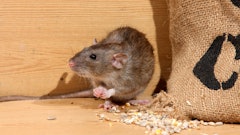
Unless a facility has extremely poor interior sanitation conditions, filth flies, like house and bottle flies, are probably not breeding indoors. More commonly, these flies are coming in from outside, often attracted to the site by odors. One of the main exterior attractants at a distribution center is the dumpster compactor area.
When it comes to fly management programs, the dumpster compactor area should be a targeted area for integrated pest management strategies for filth fly control. The integrated pest management strategies around dumpsters will include improved sanitation, exclusion and the use of chemicals to supplement the non-chemical methods.
Sanitation Improvements: A Dumpster Can be a Moving Experience
Wriggling maggots can hide in, around and underneath the dumpster. Daily clean up around the dumpster compactor should be performed to make sure that spillage and debris is kept to a minimum. One statistic states that 800 fly maggots can be found in just one ounce of organic debris. Cleaning efforts should take into consideration the small amount of moist organic waste, which can produce a lot of flies.
In addition to day-to-day efforts, opportunities for more detailed cleaning should be sought. Coordinate clean-up underneath and around the dumpster compactor unit when the dumpster is removed by the waste hauler. Debris can accumulate between the dumpster and the compactor, which cannot be easily cleaned when the dumpster is in place.
It also is important to make sure that the hauler provides a dumpster that is delivered free of heavy waste deposits and maggots. Periodically inspect the condition of the dumpster when it is delivered for signs of excessive organic debris residue and pest activity. If they simply dump the waste but use the same dumpster box, that dumpster box will need to be cleaned prior to its return.
Check the paved area and pad while the dumpster is removed, inspecting for signs of cracked pavement and maggots. It is not uncommon to find maggots underneath a dumpster that has been moved for disposal. Repairs should be scheduled if the pavement is cracked or damaged in order to eliminate areas where organic material is collecting and where maggots are living.
Trash receptacles placed around the exterior of the facility for employee and visitor personal trash should have self-closing lids and be emptied frequently—at least once per week. Some pest flies can complete their life cycle in less than one week. The longer the trash remains, the more likely the flies will have sufficient time to complete their life cycle. Even small flies like phorid and fruit flies will move into buildings if trash receptacles are located close to the facility. This is especially true when the trash receptacle is located near a frequently opened pedestrian door. It is common to place a trash receptacle near an employee entrance so trash can be discarded before entering the building. However, this may attract flies to the building. Self-closing lids may not totally prevent pest access, but will discourage foraging and reduce odors, which can attract pests to the receptacle and the structure.
Exclusion
It is critical to reduce openings around the structure near the highly attractive dumpster compactor. If doors are left open, or the building is not pest-proof, flies attracted to the dumpster will make their way into the building. Educate employees regarding the importance of keeping doors closed while not in use. If doors need to be left open for ventilation purposes, screens should be installed.
It is advisable to place personnel doors, such as those used for outdoor break areas or employee entrances, away from dumpster compactor areas. Frequently used doors placed in areas where pests congregate will increase the chance of pest introduction. If there are frequently used doors near areas which are highly attractive to flies, strengthen fly control efforts in those areas, both on the exterior and interior.
Lastly, corrugate metal buildings, which are commonly used in warehousing, can be particularly difficult to seal and keep sealed. Look for areas where there may be gaps in the corrugation wall/ foundation juncture. Check to make sure that areas where pipes enter the structure are sealed at the wall junctures as well. Regardless of the construction type, maintain a well-sealed building.
Chemical Control
Treatments can be performed using residual insecticides, bioremediation products and fly baits. Recently, there have been several fly baits introduced with excellent labels for both exterior and interior food areas. Labeled applications for food areas will have greater restrictions. All labels must be followed. Baits are well-suited for targeting both interior and exterior trash.
Bioremediation products can be used to help break down organic materials that flies feed on. They contain specially formulated beneficial bacteria which help break down wastes that attract and feed flies. Some of the bioremediation products also contain essential oils. With a combination of the waste reducing properties and the pleasant odors of the essential oils, fly attracting odors are reduced. These products can be applied using a foaming device, sprayer or applied through mister type systems on an ongoing basis. The key to these products is to apply them routinely. As new wastes are deposited, the bioremediation products need to be reapplied. Bioremediation products often are used indoors in drain cleaning programs, but can also be beneficial outdoors.
Residual insecticides in the form of liquid applications also can offer protection, and should be considered in both preventative and remedial fly control programs. Use products of varying insecticide classes, and avoid reliance on the most common class of pyrethroids. Pyrethroid-based products used on a routine basis can cause control failures since fly populations may be resistant or can easily become resistant to this group of insecticides. Insect growth regulators, which inhibit normal fly development, also are beneficial in situations such as the immature stages of flies or maggots. When maggots are breeding around a dumpster, use of an insect growth regulator can be extremely beneficial.

















